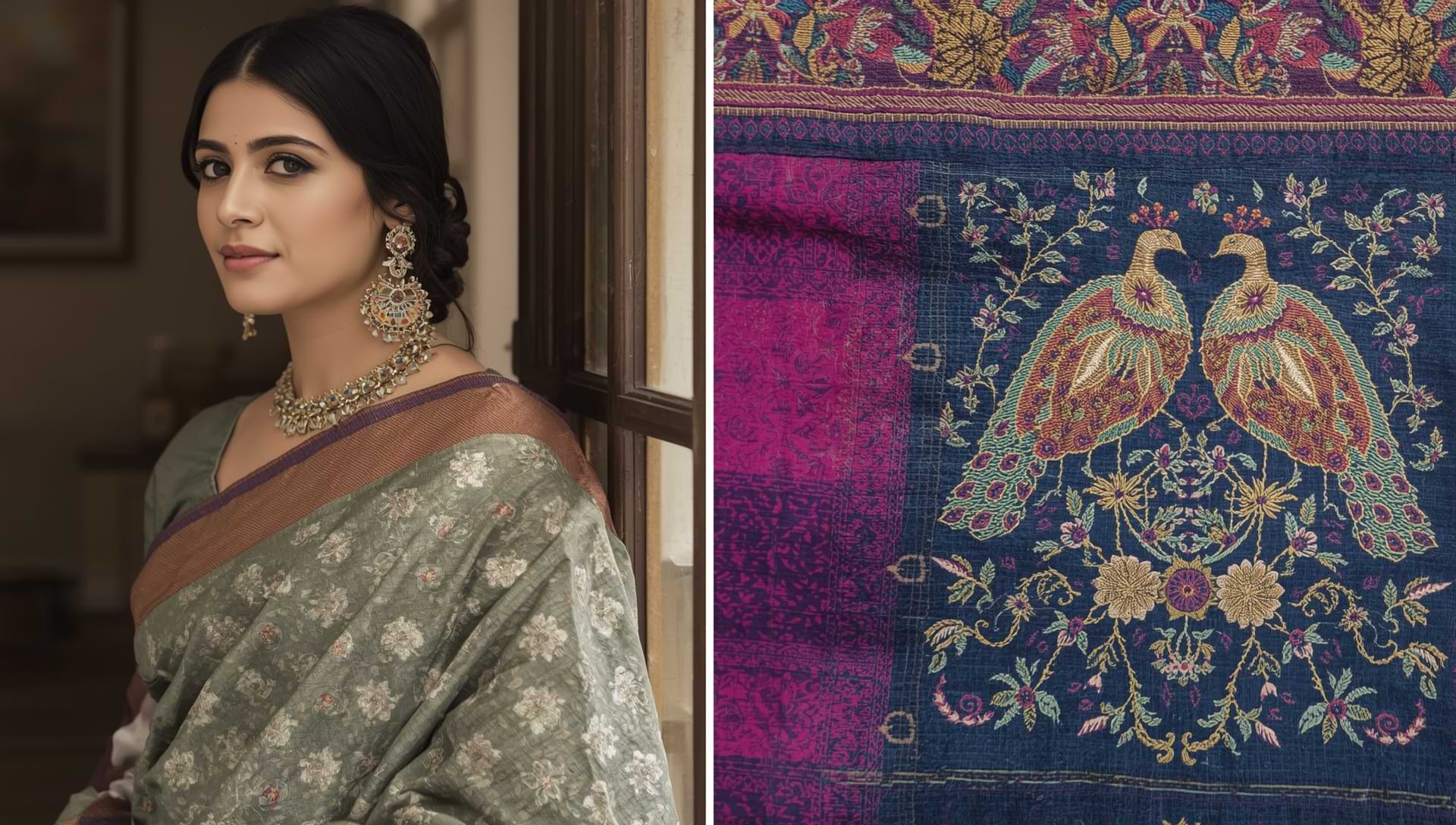Khadi Cotton Saree: Tradition Meets Modern Grace
Kantha Stitch Saree: Handcrafted Elegance from Bengal
India is home to a variety of textiles and embroidery traditions, each telling a unique story of culture and craftsmanship. The Kantha stitch saree from Bengal is especially notable for its intricate artistry and timeless elegance. Known for its delicate hand embroidery and motifs inspired by folklore, nature, and daily life, Kantha sarees blend heritage and style, enchanting women across generations.
The Origins of Kantha Embroidery
Kantha embroidery has its roots in rural Bengal. Women would recycle old fabrics by layering them and stitching them together with running threads to create quilts, covers, and clothing. The word “Kantha” means patched cloth. Over the centuries, this art evolved into a fine embroidery style that adorns sarees, dupattas, and home décor items. Traditionally, Kantha was more than just a craft; it was a way to tell stories. Artisans depicted myths, rituals, animals, and floral patterns through their needlework.
Unique Features of Kantha Stitch Sarees
Intricate Handwork: Every saree is hand-embroidered with simple running stitches that create detailed motifs.
Cultural Narratives: The designs often showcase folklore, village life, geometric patterns, and symbolic elements.
Lightweight & Comfortable: Unlike heavily embellished sarees, Kantha stitch sarees are soft, making them ideal for daily wear or casual gatherings.
Art Meets Sustainability: Born from fabric recycling, Kantha continues to represent sustainable fashion.
Fabrics Used in Kantha Sarees
Kantha embroidery isn’t limited to one type of fabric. Artisans use cotton, silk, tussar, and georgette as canvases for their designs.
Cotton Kantha Sarees: Lightweight and perfect for summer wear.
Silk Kantha Sarees: Elegant drapes suited for festive and formal occasions.
Tussar Kantha Sarees: Luxurious texture with earthy appeal, popular among fashion lovers.
Styling Kantha Stitch Sarees

The versatility of Kantha sarees allows them to complement both traditional and contemporary wardrobes. Here are some styling suggestions:
Pair a cotton Kantha saree with oxidized jewelry for a graceful ethnic look.
Drape a silk Kantha saree with minimal gold jewelry for weddings and festive celebrations.
Modern women often style Kantha sarees with statement blouses, belts, and even jackets for a fusion touch.
Why Kantha Sarees Are Timeless
The charm of Kantha stitch sarees is not only in their embroidery but also in the stories they carry. Each piece reflects hours of careful handwork by artisans, preserving a cultural identity that is centuries old. Amid the rise of fast fashion, Kantha sarees stand out as symbols of slow, ethical fashion. By choosing one, you wear an elegant garment while supporting rural women artisans and preserving an ancient craft.
Kantha Saree in Modern Fashion
In recent years, Kantha stitch sarees have gained global recognition. Designers have reinvented them with contemporary styles, fusion drapes, and Indo-Western looks. Bollywood celebrities and influencers often showcase Kantha work, giving this traditional art a modern stage. With an increasing demand for sustainable and handmade fashion, Kantha sarees continue to shine both in India and abroad.
Care Tips for Kantha Sarees
Always dry clean silk or tussar Kantha sarees.
Store them in a cotton cloth to protect the embroidery.
Avoid direct sunlight for long periods to prevent fading.
For cotton varieties, gentle hand washing works best.
Final Thoughts
A Kantha stitch saree is more than just clothing; it is a work of art that carries centuries of heritage, women’s creativity, and cultural pride. Whether you wear it for festive occasions, office settings, or casual outings, a Kantha saree will always make you stand out with its unique elegance. Investing in one is not just about fashion; it’s about embracing tradition and supporting the sustainability of Indian handloom.


